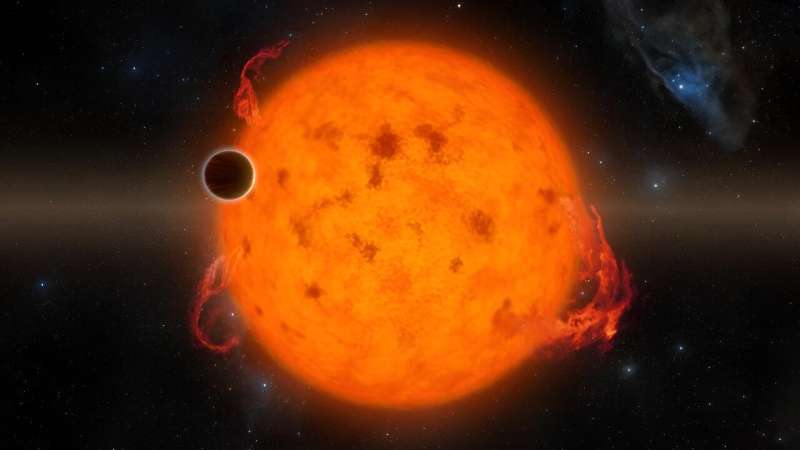
This artist’s concept shows exoplanet K2-33b transiting its host star. Many citizen science projects at NASA invite the public to use transit data to make discoveries about exoplanets. Credit: NASA/JPL-Caltech
NASA’s upcoming flagship astrophysics missions, the Roman Nancy Grace Space Telescope and the Habitable Worlds Observatory, will study planets outside our solar system, known as exoplanets. More than 5,000 exoplanets have been confirmed to date—and given that scientists estimate that at least one exoplanet exists for every star in the sky, the hunt is just beginning.
Discoveries of exoplanets by the Roman Observatory for Habitable Worlds can be made not only by professional researchers, but also by interested members of the public, known as citizen scientists.
Exoplanet research has a long involvement with citizen science. NASA’s TESS mission (Transiting Exoplanet Survey Satellite) and the now-retired Kepler mission, which are responsible for the vast majority of exoplanet discoveries to date, made the observations freely available to the public immediately after processing. This open science policy paved the way for the public to become involved with NASA’s exoplanetary science.
NASA’s Planet Hunters TESS Project invites the public to classify exoplanet light curves from TESS online. Another project, Exoplanet Watch, enables citizen scientists to collect data about known exoplanets, submit their observations to NASA’s public record archive, and receive credit if their observation is used in a scientific paper. Participants don’t even need their own telescope—Exoplanet Watch also curates data from robotic telescopes for users to process.
“Anyone around the world who has access to a smartphone or a laptop can fully participate in many of these citizen science efforts to help us learn more about the cosmos,” said Rob Zellem, project leader and project scientist. for Exoplanet Watch and astrophysicist. at NASA’s Goddard Space Flight Center in Greenbelt, Maryland.
NASA’s citizen science projects have discovered several new planets from Kepler and TESS data. They’ve also helped scientists perfect the best time to observe important targets, saving hours of precious observing time on key current missions like NASA’s James Webb Space Telescope.
The Roman and Habitable Worlds observatories offer even more opportunities for citizen science. Expected to launch by May 2027, Roman will detect exoplanets through direct imaging, transits and gravitational microlensing. After that, the Habitable Worlds Observatory will take direct images of stars in our solar neighborhood to find potentially habitable planets and study their atmospheres.
Like Kepler and TESS before them, data from the Roman and Habitable Worlds Observatory will be available to both the scientific community and the public immediately after processing. With Roman’s probes expected to send a terabyte of data back to Earth every day—over 17 times more than Webb—there is a huge opportunity for the public to help analyze the information.
“The general public can get the Roman data as quickly as I can as a scientist working on the mission,” said Zellem, who also serves as the deputy Roman project scientist for communications at NASA Goddard. “That really makes Roman a mission for everyone and anyone.”
Although the full capabilities and instrumentation of the Habitable Worlds Observatory have yet to be finalized, citizen science involvement is expected to continue. The team behind the mission is embracing a community-oriented planning approach by opening working groups for volunteers who want to contribute.
“It’s already setting the tone for open science with the Habitable Worlds Observatory,” said Megan Ansdell, program scientist for the mission at NASA headquarters in Washington. “The process is as open as possible and these working groups are open to anyone in the world who wants to join.” There are now more than 1,000 community working group members participating, some of whom are citizen scientists.
Future citizen science initiatives may be combined with advanced tools such as artificial intelligence (AI) for greater efficiency. “AI can be extremely powerful in terms of classifying and identifying anomalous things,” said Joshua Pepper, deputy program scientist for the Habitable Worlds Observatory at NASA Headquarters. “But assessing what those anomalous things are often requires human insight, intervention and revision, and I think that can be a really fantastic area for citizen scientist participation.”
Ahead of the launch of the Roman and Habitable Worlds Observatory, exoplanet citizen scientists still have a lot of data to analyze from the Kepler and TESS satellites, but community contributions will become even more important when data from the missions begins to pour in. cloud. As Zellem said, “We’re in a golden age of exoplanet science right now.”
citation: How NASA citizen science fuels future exoplanet research (2024, August 9) Retrieved August 9, 2024 from https://phys.org/news/2024-08-nasa-citizen-science-fuels-future. html
This document is subject to copyright. Except for any fair agreement for study or private research purposes, no part may be reproduced without written permission. The content is provided for informational purposes only.
